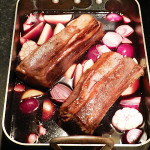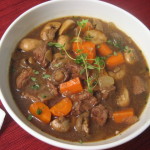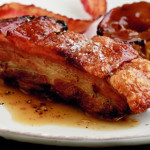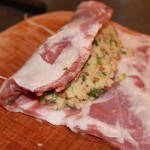Three conflicting trends you may have spotted:
- Low-fat everything, leanest possible cuts, remove every last vestige of fat from every substance you ingest, for fear you might grow morbidly obese overnight and/or develop furry arteries and die from a coronary.
- Restaurants ceased to regard the leanest, most expensive cuts as the most attractive dish to cook, and instead make a virtue of the cheaper cuts – the sort my mother used to serve.
- Inverse snobbery, where once the well-to-do used to eat fillet steak to demonstrate their affluence, but now happily scoff pork belly, ox cheek, pig’s trotter and many more slow-cook cuts that were once the preserve of the poor – in the same way that the poor were once thin and the rich fat, where the reverse is now true.
Personally I always subscribed to the second school, and it’s not difficult to see why belly pork and lamb shanks, to name but two, suddenly adorned menus everywhere and supermarket shelves soon thereafter. It was an overnight phenomenon; we consumers suddenly realised that actually you can eat well and economically using different cuts of meat, and that there are indeed virtues in slow food.
Yes, they are less tender, need longer cooking and tend to have both fat and bones, but the thing is that they taste divine and cost far less to buy and cook than prime fillet steak! What the fat-free lean school don’t appear to have twigged is that you need fat for flavour.
Supermarkets have had an increasing tendency to believe the fat reduction story, thereby commissioning from their suppliers animals with progressively less and less fat and equally little flavour. For them it’s a no-brainer, since it means they can slaughter and butcher animals at a younger age before deposits of fat have formed, and sell for a higher price, but that is a false economy in so many ways. Losing flavour from our food really is not the way to go, and we are all poorer as a result – which from the supermarket philosophy you can compensate by adding a range of artificial manufactured flavourings instead (ever noticed how chicken meat is adorned with all manner of obscure sauces to disguise the fact that it has no flavour whatever?)
The thing is that you don’t have to eat the fat or be encumbered by the bones if you don’t want to, but cooking meat with a generous natural layer of fat and on the bone makes a vast difference to the flavour of the finished product.
Don’t believe me? Try this: buy a prime pork chop with minimal fat from a supermarket, and then buy a traditional breed slow-grown pork chop from your local butcher. The latter will be much bigger and will certainly have a thicker layer of fat around it. Cook them both together for the same time, and what you will find is the supermarket chop will be comparatively dry and tasteless, where the butcher chop will be succulent and flavoursome. No contest!
Equally, you can buy humble strips of belly pork and cook them very slowly for a long while, which I do in the bottom oven of the Aga. The fat will turn crisp and the meat will be meltingly tender, and you’ll have a perfect crust of crisp crackling to enjoy – bliss! Small wonder it’s become a staple of the restaurant menu these days, albeit a bit of a cliche these days.
Try pot-roast brisket or other cheaper roasting joints, cook long and slow in a casserole with red wine, root veg and rich stock – hey presto, you have a wonderfully tender dish and perfect gravy all in one! Even good old-fashioned shin of beef will make the most mouth-wateringly tasty stews, pies and casseroles, all cooked gently to bring out the flavour. Not only that, but they taste better cooked in advance and reheated.
Can’t afford best lamb? A slow-cooked shoulder joint is great, though even humble rolled stuffed belly of lamb can make a tasty dish if you remember to cook it on a trivet so the fat drains off. Fancy perfect lamb stew? Neck of lamb on the bone makes a wonderfully tasty dish, and you can always fish out the mean, debone it and serve it in a juicy pile to one side – flavour and a visually stunning dinner into the bargain!
And all this is before we consider the virtues of ox cheeks and tail, pig’s head and offal, among many others. Some may not be to modern tastes, but they are all worth trying – offally good, in fact!! 🙂
So there you have it – take your time, cook and eat your food slowly, and don’t fall foul of the myth that you have to remove fat from food to die an agonising early death. Enjoy!
PS. And if you don’t believe me, try Nigel Slater’s recipes!









